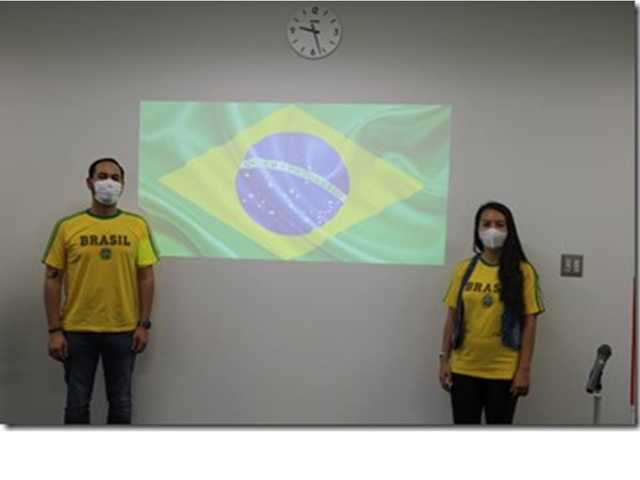 引き続き Gabrielaさんからブラジルを英語で紹介していただきます。
このセッションはブラジルの各地域の特徴です。
これで皆さんもブラジルに行った気になれること間違いなし。
写真はGabrielaさんと彼のKrisさんです。 |
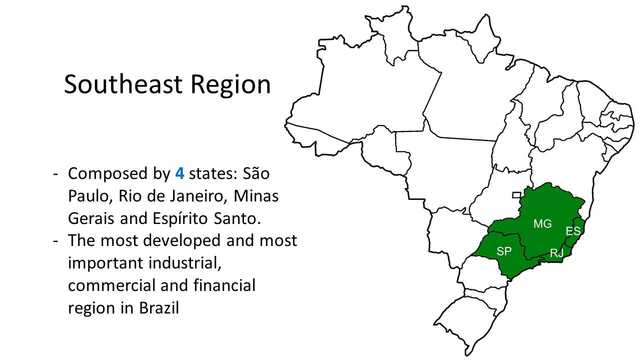 The last but no least, the South Region is the only Brazilian region located below the tropical zone, with the seasons varying markedly. The winter is severe with the possibility of snowfall and hot summer.
Ok people. So let’s continue.
Brazil is divided into regions, and each of them has a certain quantity of states. As a large country and with a lot of different influences, each region developed with great contrast from each other.
I will start with the southeast region, where is the most famous Brazilian cities: Sao Paulo and Rio de Janeiro.
It is composed by 4 states: Sao Paulo, Rio de Janeiro, Minas Gerais and Espirito Santo.
It is the most developed region in the country. Here is where 88 million people lives, almost 42% of the total Brazilian population, consuming 85% of the total produced electricity in Brazil.
|
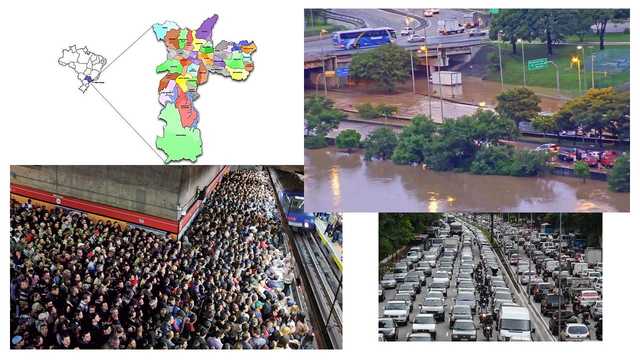 Sao Paulo city, capital of Sao Paulo state, is the most populous city in Brazil and all North Hemisphere, with 12 million people.
It is the principal financial, corporative and commercial center in South America.
As most big cities in the world, face a lot of issues like: high prices, violence, unsafety, traffic, crowded public transportation. During the rainy season, this is a common scene. The city literally stops. The traffic jam, already terrible, becomes a caos.
|
 But Sao Paulo also has its bright side: a large offer of culture, gastronomy, art and fun.
Here is the Japan House Sao Paulo. The third one in the world. The other ones are located in London and Los Angeles. It was projected by the Japanese architect Kengo Kuma. It is a initiative from Japanese Ministry of Foreign Affairs. It is located at one of the most famous spots in Sao Paulo: Paulista Avenue.
On Sundays, Paulista avenue is closed for cars, and a lot of people go to enjoy walking, skating, riding bicycles, visiting museums and going to restaurants and parks.
This is MASP, the Art Museum of Sao Paulo. It is a very iconic building and under it often happens a lot of artistic presentations and even protests.
Here is a view of the Estaiada Bridge. It is really close to my parents house. It was build in 2008 and become an iconic spot of Sao Paulo.
Here is Ibirapuera Park, the most famous Park in Sao Paulo, with 390 acres, that correspond to around 158 soccer fields.
You can do a lot of different activities: walking, running, skating, riding a bike, going to one of the 5 museums or watching a play or dance spectacle. There is a large area that often receive big events and music shows. And there is a Japanese garden too. The building was inspired in Katsura Palace from Kyoto.
|
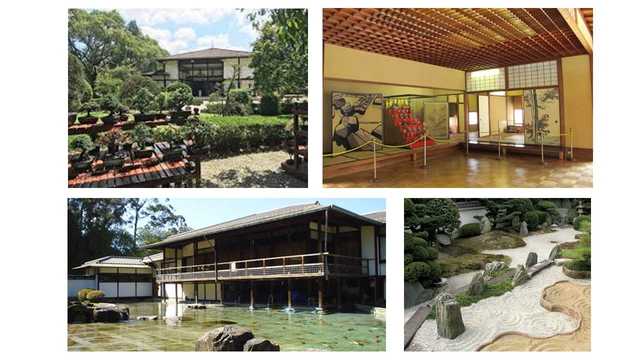 Here inside and outside.
|
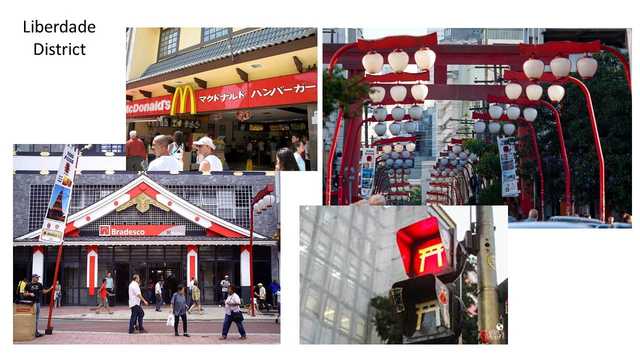 In Sao Paulo city, where most of the Japanese descendants are today, the immigrants established near the center of the city, a District called Liberdade (literal translation: Freedom).
Here some examples of Japanese influence. Mc Donalds front door written in Japanese. The lamp streets. This is the bank of Bradesco. And the pedestrian lighting with torii form.
|
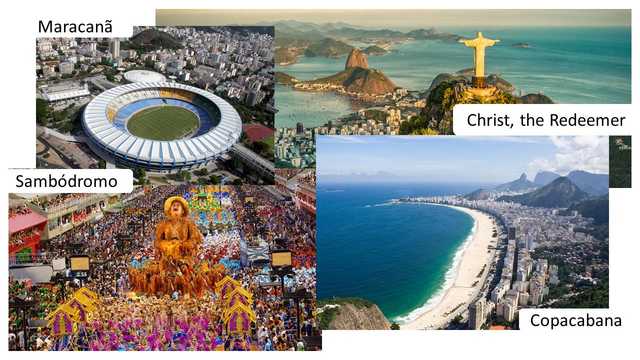 And the most famous city in Brazil: Rio de Janeiro. And probably the first things many people think about Brazil: soccer, samba and beaches. Here is Maracana, Sambodromo the Samba Arena, where ten Samba Schools make a parade of one hour every year. It also has in Sao Paulo. And here is Copacabana Beach. And the Christ, the Redeemer, one of the seven modern wonders in the world. Here is Pao de Acucar, where you can ride a cable car to the point.
|
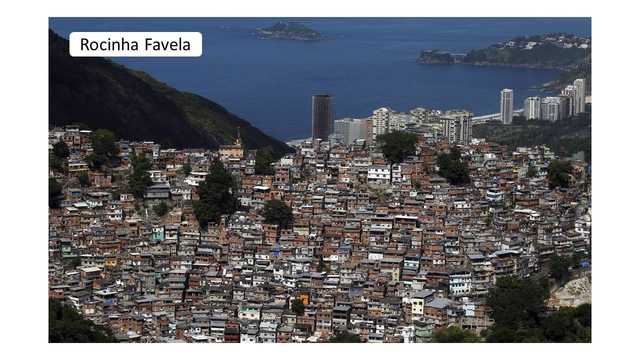 And also something famous about Brazil: favelas. You can find in every city, but Rocinha is the biggest in the country. A lot of people living in simple and small constructions.
|
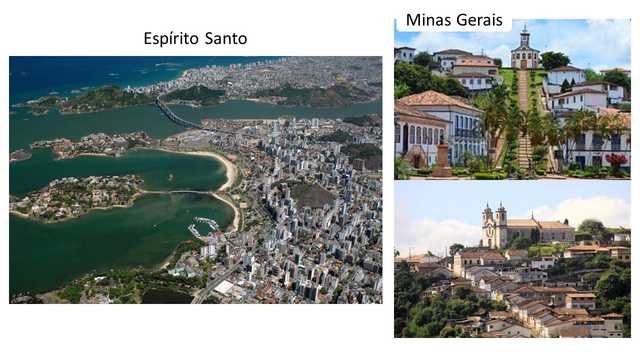 And here some photos of the other two states that are overshadowed by Sao Paulo and Rio de Janeiro: Espirito Santo has a lot of beautiful beaches and amazing countryside nature.
Minas Gerais is better known for its religious heritage, and has a lot of historic and iconic churches. And a huge number of slopes, it is a great leg work out to visit this spots.
|
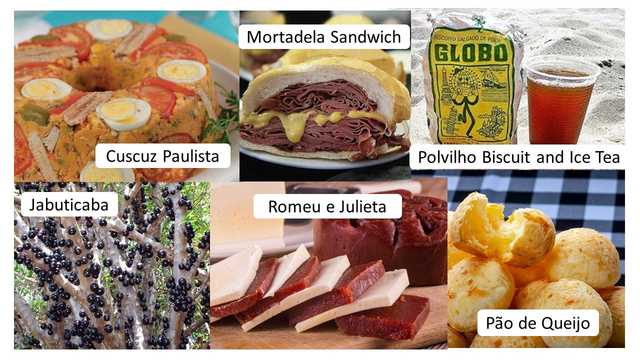 And these are some examples of food from this region.
Cuzcuz is actually an adaptation of the famous moroccan dish, but made with corn flour not semolina, and vegetables and tuna or sardine.
This is something you must-eat when in Sao Paulo: mortadela sandwich. Mortadela is like a ham, but contains many types of meat, not only pork.
And this is what you will eat in the beaches of Rio de Janeiro: Polvilho biscuit and ice tea. This biscuit is also made from kasava startch and is really crunch.
This is jabuticaba, one of the dozen typical fruits from Brazil. But this one is original from this region. It grows on the branches of the trees, is really sweet and looks like a grape.
This is a combination between brazilian cheese, which has a lighter taste and creamy consistency, and a kind of pudin of brazilian guava. This combination become so famous and appreciated in Brazil that has an interisting name: Romeo and Juliet. So if you go to any restaurant and order Romeo and Juliet, this is what you will receive.
And this is the brazilian cheese bread. It is also made from kasava starch and has this sticky consistence inside, and it is crunchy outside. Inside remembers a mochi. And goes well with a cup of coffee and milk too.
Minas Gerais is the most famous cheese producer in Brazil, like Hokkaido in Japan, so everything with dairy from here has an amazing taste and great quality. |
 Here is where the Amazon Rainforest is located.
It is the biggest region in Brazil, almost 43% of the total territory. But is also where lives the minor population, representing only 9% of the total in Brazil.
It is composed by 7 states: Acre, Amapa, Amazonas, Rondonia, Roraima, Para and Tocantins, the newest state in Brazil, established in 1988.
Here the weather is a little bit different from the rest of Brazil, the tropical weather. The equatorial weather is characterized by high humidity and high temperatures, going from the minimum 20 to maximum 36 degrees. The rainy season is long and strong, which make the rivers full almost all over the year.
|
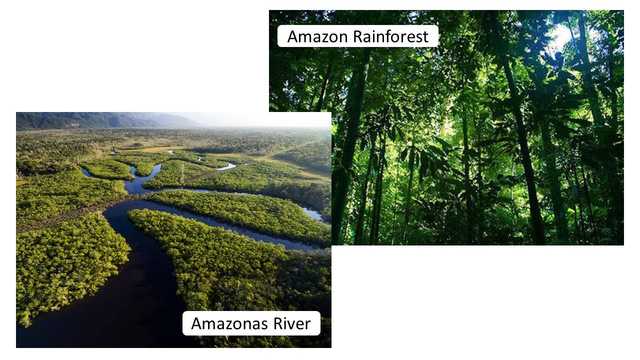 And here the largest, most variety and densest forest in the world.
Here is Amazonas River, the largest river by discharge of water volume in the world and represents 20% of the global liquid fresh water.
|
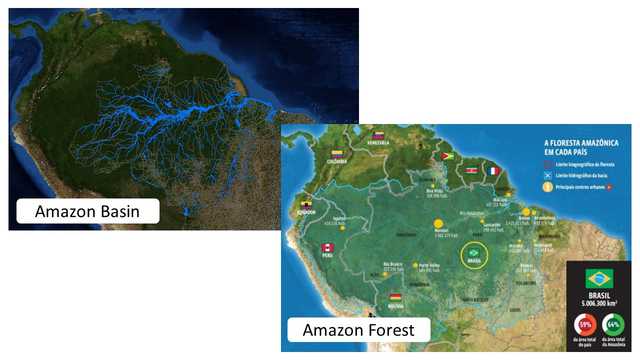 Here a satellite view to see the size of the Amazon basin which is the largest in the world. Here is the amazon river.
Here is where the Amazon Rainforest is located. 64% it is located in Brazil, which represents 59% of the Brazilian territory. Represents also 67% of world’s rainforest and has one third of all the tree species in the world. But unfortunately due to deforestation, is decreasing more and more.
|
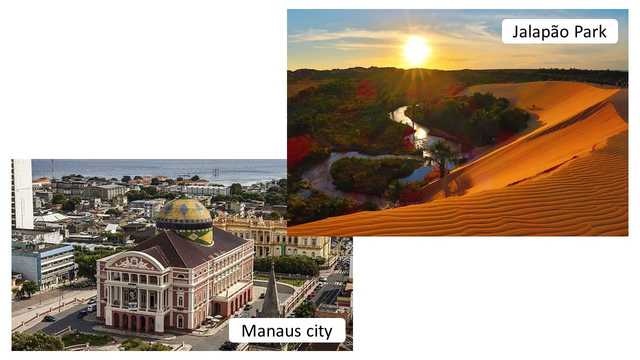 Manaus is the biggest city in the North Region and had great influence from Europeans. This is the Manaus Theater, an important historical building.
And Jalapao Park, an wild park with dunes, waterfalls, rivers with crystalline waters that is really hard to access. Only by off-road vehicles in bumpy roads. During the rainy season is unreachable.
|
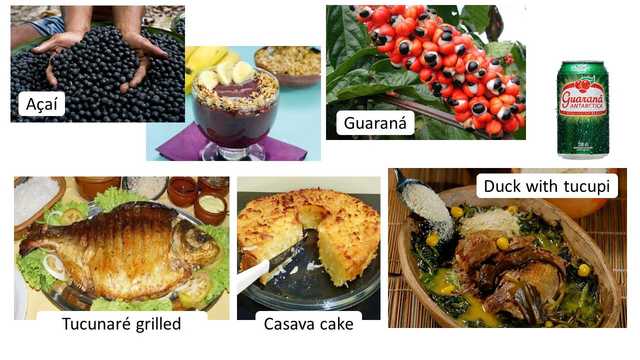 More food!
Here is a fruit called Acai. It is appreciated all over Brazil, and we eat it like an ice cream, with various toppings, like fruits and grains. But in the North they eat it in its natural temperature with rice and beans, like mashed potatoes. The taste reminds beet, so we mix with the syrup of this fruit here: Guarana. It has an interesting shape, looks like an eye. And it is the flavor of the most famous Brazilian soda, that actually you can find easyly here in Japan.
In the North the basic food is of course, fish. This one is just one type of the enormous species and ways of prepare.
This is casava cake. With coconut and sugar, it is creamy and fluffy at the same time. Perfect combination with a coffee.
This is duck with tucupi. Tucupi is the juice of the kasava’s root. After peeled, grated, squeezed, it rests for some hours to detach the starch from the liquid. Then the liquid is boiled and fermented for 5 days. And you eat it with farofa.
|
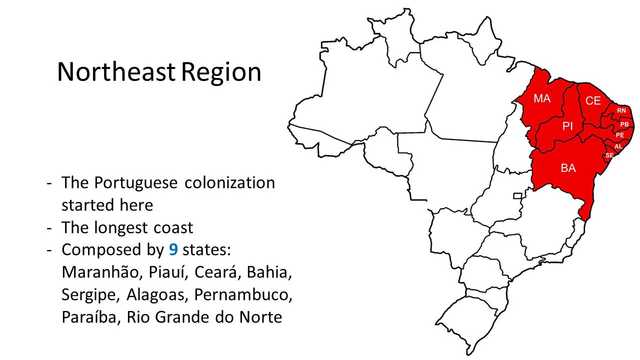 Next is the Northeast Region.
Here is where the Portuguese arrived in Brazil. So there are many historic buildings in most part of the cities.
It is the region with the longest coast, becoming the most famous and popular destination for holidays with paradisiac views.
It is composed by 9 states: Maranhao, Piaui, Ceara, Bahia, Sergipe, Alagoas, Pernambuco, Paraiba, Rio Grande do Norte
In the middle of the region it is the most dry area in Brazil. People living here suffer a lot with the dry season, because there is no water at all.
Northeast Region is also the poorest region in Brazil.
|
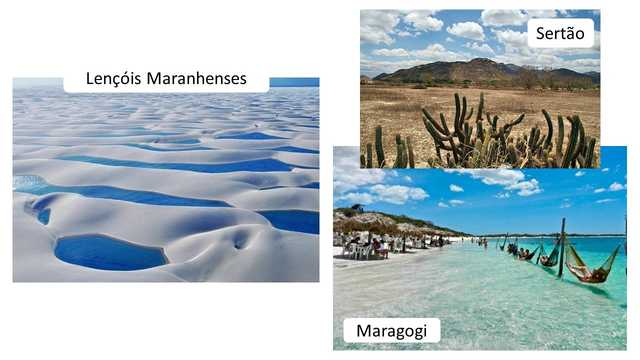 There are a lot of spectacular beaches here, but there is also a peculiar landscape called Lencois Maranhenses. It is formed by sand dunes and after the rainy season, a lot of blue lagoons are formed.
Here is how the dry area looks like. Really similar to a desert.
And this is only one example of the infinite beaches in Northeast. Here you can relax inside the water, lying in a hammock. The water in Northeast is hotter than other coasts of Brazil.
|
 And here again more food. In Northeast they use a lot of coconut, spicy and dende oil, made from palm fruit, it is red and has a strong taste.
Acaraje is a cake made of mashed black-eyed peas and it is served with dry shrimp, spicy, vatapa that is a cream with a lot of things mixed like ginger, peanuts, onion, tomatoes, garlic. It is an African dish, and really popular in Africa too.
This is also an heritage from the slaves. It is grated coconut with melted sugar. The colour can vary depending on the time it remains in the pan, the kind of the sugar and if any fruits is added. This one for example is made with passion fruit.
Pamonha is a paste made from corn that is wraped in corn husks and boiled. Can be savoury or sweet. It is an indigenous heritage, and the name in indigenous language means sticky.
Sarapatel is a Portuguese dish, but in Brazil is made with pork or goat. It is used mostly the entrails and contains curdy blood too. So it has a strong taste and a high content of fat. It is commonly eaten before an activity that requires a lot of energy.
|
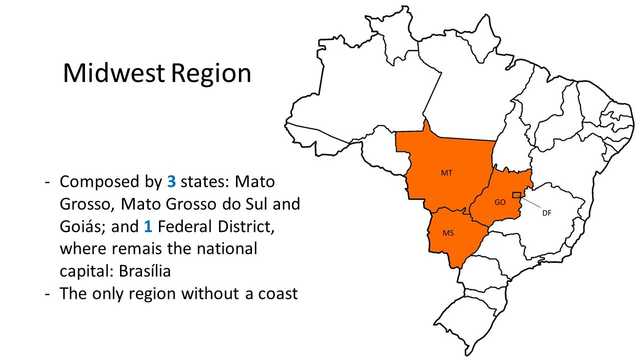 Here is the Midwest Region.
It is the second largest region in area but the second less populous. It is the only one that borders with all the others regions, even though the only one without a coast.
Composed by 3 states and 1 Federal District, where Brasilia, the national capital is located.
There are many indigenous living here too.
|
 Here is Brasilia. It has the shape of a plane. So the city is divided into Wing North and Wing South. It was concluded in 1960.
In the country side there is a vast landscape called Chapada dos Veadeiros, with a lot of trails, waterfalls and nature.
|
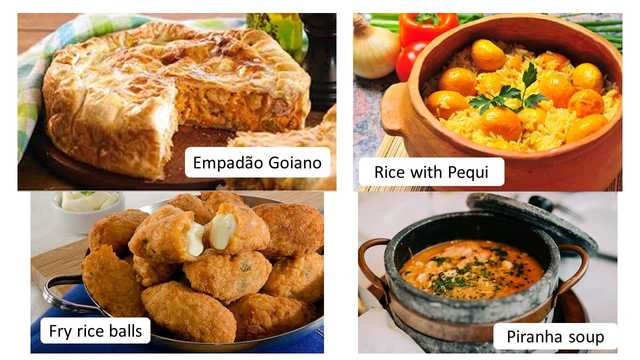 Here are the traditional food of Midwest.
Empadao goiano is like a pie. Inside is very creamy and outside is a little crusty. It has Portuguese and Spanish influence.
Rice with Pequi: Pequi is a typical fruit from this region. The taste is strong, a bit citric. And you can eat it in every way: fruit, desserts, dishes.
Fry rice balls: it is a simple dish, but really appreciate in this area. It is made with rice, kasava and butter. It is possible to fill with cheese.
Piranha Soup: made with Piranha, fish with sharp teeth, and a lot of spicy.
|
 Here is Bonito, the most popular ecotouristic destiny in Brazil. There are a lot of crystalline rivers where you can float with the fishes. And there is also this curious place, called Anhumas Abyss. The entrance is a crack, than 72 meters of vertical descent with ropes. It is possible to dive in it and see until 18 meters deeper in the water.
And here is a unique landscape called Pantanal. It is the world's largest tropical wetland area. Roughly 80% of the Pantanal floodplains are submerged during the rainy seasons, nurturing a biologically diverse collection of aquatic plants and helping to support a dense amount of animal species |
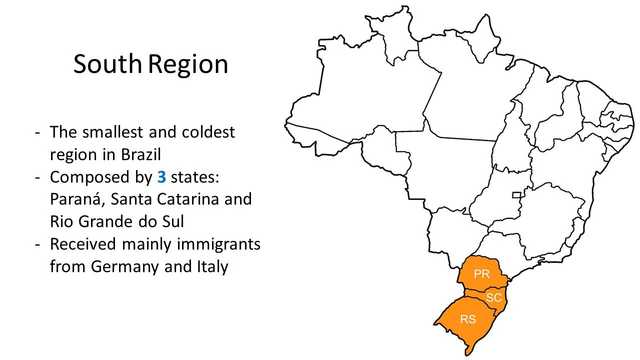 The last but no least, the South Region is the only Brazilian region located below the tropical zone, with the seasons varying markedly. The winter is severe with the possibility of snowfall and hot summer.
It is the smaller one but the second most populous.
Received mainly immigrants from Germany and Italy
It is composed by Parana, Santa Catarina and Rio Grande do Sul. Gisele Bundchen, the most famous brazilian model was born here (RS). She has germany descendance.
|
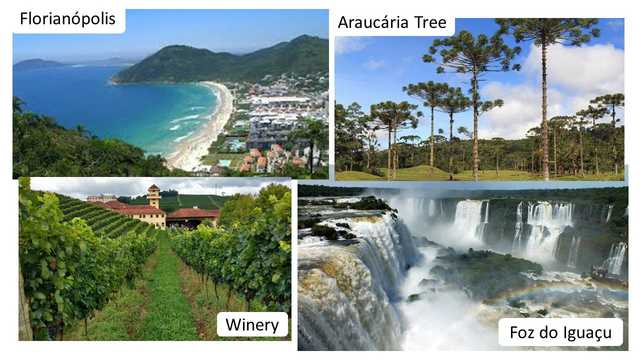 So you can enjoy various landscapes too.
Florianopolis is famous for beautiful beaches. It has an interesting fame of the state with the most beautiful people in Brazil.
This is a tree that in Brazil is only founded in this region. It has this funny shape, with a long body and few leaves in the top.
Joining the Italian and Spanish immigrants and an ideal wethear, the wine culture took place. There are a lot of wineries, including some with international awards.
Here is the Iguacu Waterfalls. It has the largest volume in the world and it is an important source of energy for Itaipu Usine. A fun fact: one side is brazilian, and the other is Argetine. Here was the place where I saw the couple of Tucanos.
|
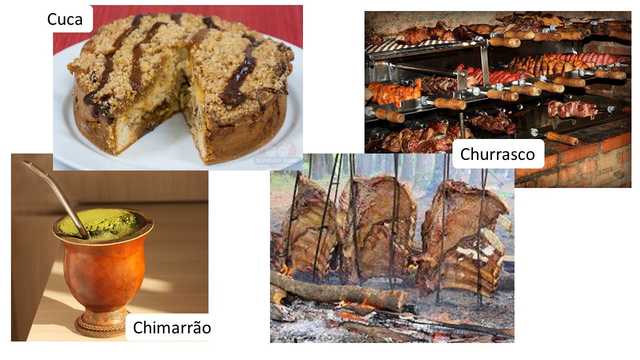 More food people, sorry.
This is Cuca, it is very similar to a traditional german cake that I have no skills to pronounce the name. It is very appreciate in the South. There is even a Cuca Festival here. It is a cake with a sandy dough in the bases, a cream above and with diverses toppings like sugar, dry fruits and nuts.
Here is the root of Brazilian Barbecue. Brazilian barbecue is the most popular type of gathering between family and friends. Anything can be a reason to make a barbecue: wedding, newborns, engagement, religious party, birthdays. The people from the south use wood instead of charcoal and they use this sticks inside the ground. In other places this is more common and practic, as long not everyone has a space to do it in the traditional way.
This is the symbol of this region: Chimarrao, a drink that consists of a gourd (made of wood), iron straw,ground mate herb and water at approximately 70 degrees. It is also widely appreciate in Argentina, Uruguay and Paraguay, known with the name Mate.
|
























